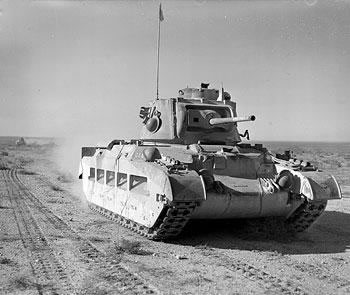Operation Compass was an Allied campaign against Italian forces in North Africa during World War II. It resulted in an overwhelming victory for the Allies, largely due to the superiority of British tanks over Italian ones.
In June 1940, Italy declared war on France and Great Britain. At the time, Libya was an Italian colony. Libya’s neighbor, Egypt, was a former British protectorate and had a strong British military presence.
Great Britain retained control of the strategically important Suez Canal. The Italians wanted to control the Suez Canal. They also wanted to capture Egypt, which separated Italy’s forces in Libya from its forces in Italian East Africa (Ethiopia, Eritrea and part of what is now Somalia).
 After Italy’s declaration of war, Italian forces began raiding Egypt and a number of skirmishes took place between Italian and Commonwealth forces.
After Italy’s declaration of war, Italian forces began raiding Egypt and a number of skirmishes took place between Italian and Commonwealth forces.
The British decided that they needed to send tanks into North Africa to defend their territory from the Italians. Thus, Operation Compass was conceived.
British armored forces arrived in September 1940. These included an infantry tank regiment equipped with Matilda IIs, a light regiment equipped with Mark VI light tanks, and a cruiser tank regiment with A9s, A10s and A13s. These regiments all joined the 7th Armoured Division, which became known as the Desert Rats.
Facing British forces was an Italian armored force made up of about 1,500 armored vehicles, most of which were L3-35 light tanks – upgraded British Carden-Loyd Mark VI tankettes. These tanks had very thin armor and had only machine guns as weapons.
A small number of M11/39 and M13/40 medium tanks were also used by the Italian forces. The armor on the M11/39s was not much thicker than the armor on the L3-35s. However, each of the M11/39s had a 1.46 inch (37mm) hull-mounted gun in addition to two machnine guns in the turret.
The M13/40 was the best tank that the Italian’s had. It had thicker armor and better armament than the M11/39. The M13/40s were each armed with a 1.85 inch (47mm) gun in the turret, as well as three machine guns and an anti-aircraft gun.
Nevertheless, the M13/40 was still no match for the British Tanks. In addition to having inferior armor and firepower, the M13/40 often broke down in the desert. It caught fire easily, as well.
The Italians began to advance eastward toward Egypt, moving slowly and carefully. Eventually, they fortified themselves in new positions in Egypt, particularly in the area around the town of Sidi Barrani. About 80,000 Italian soldiers with about 120 tanks were stationed around Sidi Barrani.
The British had about 30,000 men and 275 tanks in Egypt. These were under the command of General Archibald Wavell, who decided to launch a preemptive attack.
On December 9, Lieutenant-General Richard O’Connor, Wavell’s subordinate, led the 7th Royal Tank Regiment on a surprise assault against an Italian camp at the Egyptian town of Nibeiwa. Operation Compass had begun.
British tanks attacked along with the 4th Indian Infantry Division. The British Matildas were able to overrun 23 M11/39 tanks before their crews had them prepared for action. When the Italians were able to get their tanks to fire at the Matildas, they discovered that the Matildas were very hard to damage.
The Italians were demoralized and the British took thousands of Italians as prisoners.
The following day, the Allies attacked Sidi Barrani. The attack was successful and the Italians surrendered on December 11. Around 14,000 Italian prisoners and 65 artillery pieces were captured.
In January, Commonwealth forces, led by Australia’s 6th Infantry Division, attacked the Italians at the Bardia, in Libya. Once again, the Italians surrendered. The Allies were able to take about 40,000 prisoners, about 125 tanks and about 460 artillery pieces.
The Allies then moved on to the Libyan town of Tobruk. Again they were succesful against the Italians, capturing about 25,000 prisoners, 85 tanks and 200 artillery pieces.
After the success at Tobruk, the Allies advanced toward Mechili, also in Libya. However, by this time, they were low on resources, including fuel. The only tanks that the British had left were 95 light tanks and 50 cruiser tanks. With the Allied forces weakened, the Italians were able to use their M11/39 medium tanks to temporarily hold their ground. Eventually, the Italians evacuated Mechili, which was then taken by the Allies, who were, however, unable to take any prisoners.
In February 1941, the Allies learned that the Italians were planning to retreat from Benghazi in Libya and to withdraw from all positions east of it, meaning that they were going to leave Egypt.
O’Connor decided to attack the Italians as they were retreating. The Allies trapped the Italians at Beda Fomm in Libya. Although the British were outnumbered, they were able to defeat the Italians, taking 20,000 Italians as POWs. The Italians surrendered on February 7, 1941.
By the end of Operation Compass, the Allies had completely defeated the Italian Tenth Army, taking a total of about 120,000 prisoners, about 400 tanks and 850 artillery pieces. The Allies, on the other hand, suffered less than 2,000 casualties. The Matilda’s success at routing the Italians from Egypt led to her being nicknamed the “Desert Queen.”